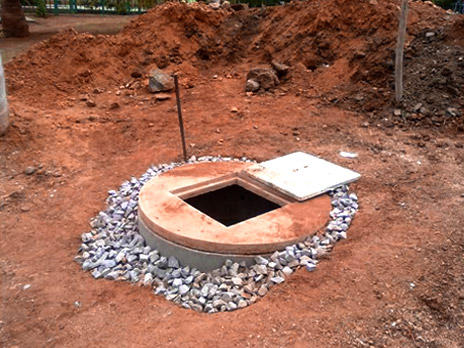Rainwater harvesting at a software company
A software firm located on the outskirts of Bengaluru had been facing perpetual water shortage issues. It depended on external tanker supply and its campus borewells. With a population of 8000, it had a daily water demand of around 200 KL. Adopting a proactive approach towards securing its water supply, the company management started exploring rainwater harvesting measures and engaged in a discussion with Biome.
With an abundant rooftop area (~120,000 sq ft), it was only natural to tap this runoff and store it in the sump which had a capacity of 200 KL. Also, the campus had a large landscaped area and a well designed network of stormwater drains. So recharging the groundwater table was also considered, rather than letting the storm water drain into the sewage laden Vrishabhavathi that cuts across the campus.
It was decided to execute the project in phases and therefore a part of the rooftop was considered for the pilot phase. First rain separators and Rainy FL500 filters provided the job of physical filtration before sending the water to the sump. The water from the raw water sump passes through a treatment system consisting of a pressure sand filter and a chlorine doser. With this system, there is a potential to harvest around 973 KL in a year with normal rainfall.


Five recharge wells, each 4 ft wide and 20 ft deep were dug at points observed to get the maximum stormwater runoff. The substrate was pretty rocky beyond 18 feet in the case of a couple of wells. Basic filtration is done with the help of concrete meshes and gravel positioned just upstream of the recharge wells.
Rainwater harvesting at a software company
A software firm located on the outskirts of Bengaluru had been facing perpetual water shortage issues. It depended on external tanker supply and its campus borewells. With a population of 8000, it had a daily water demand of around 200 KL. Adopting a proactive approach towards securing its water supply, the company management started exploring rainwater harvesting measures and engaged in a discussion with Biome.
With an abundant rooftop area (~120,000 sq ft), it was only natural to tap this runoff and store it in the sump which had a capacity of 200 KL. Also, the campus had a large landscaped area and a well designed network of stormwater drains. So recharging the groundwater table was also considered, rather than letting the storm water drain into the sewage laden Vrishabhavathi that cuts across the campus.
It was decided to execute the project in phases and therefore a part of the rooftop was considered for the pilot phase. First rain separators and Rainy FL500 filters provided the job of physical filtration before sending the water to the sump. The water from the raw water sump passes through a treatment system consisting of a pressure sand filter and a chlorine doser. With this system, there is a potential to harvest around 973 KL in a year with normal rainfall.


Five recharge wells, each 4 ft wide and 20 ft deep were dug at points observed to get the maximum stormwater runoff. The substrate was pretty rocky beyond 18 feet in the case of a couple of wells. Basic filtration is done with the help of concrete meshes and gravel positioned just upstream of the recharge wells.


The next phase will focus on tapping the remaining rooftop area and adding more recharge wells based on the percolation rates observed in the current recharge wells.
Though the management had initial apprehensions regarding the impact on aesthetics due to the RWH system, all fears were put to rest after the implementation and they are keen to get going with the next phase of design and implementation.
This is definitely a model worth emulating by other organisations.


The next phase will focus on tapping the remaining rooftop area and adding more recharge wells based on the percolation rates observed in the current recharge wells.
Though the management had initial apprehensions regarding the impact on aesthetics due to the RWH system, all fears were put to rest after the implementation and they are keen to get going with the next phase design and implementation.
This is definitely a model worth emulating by other organisations.
